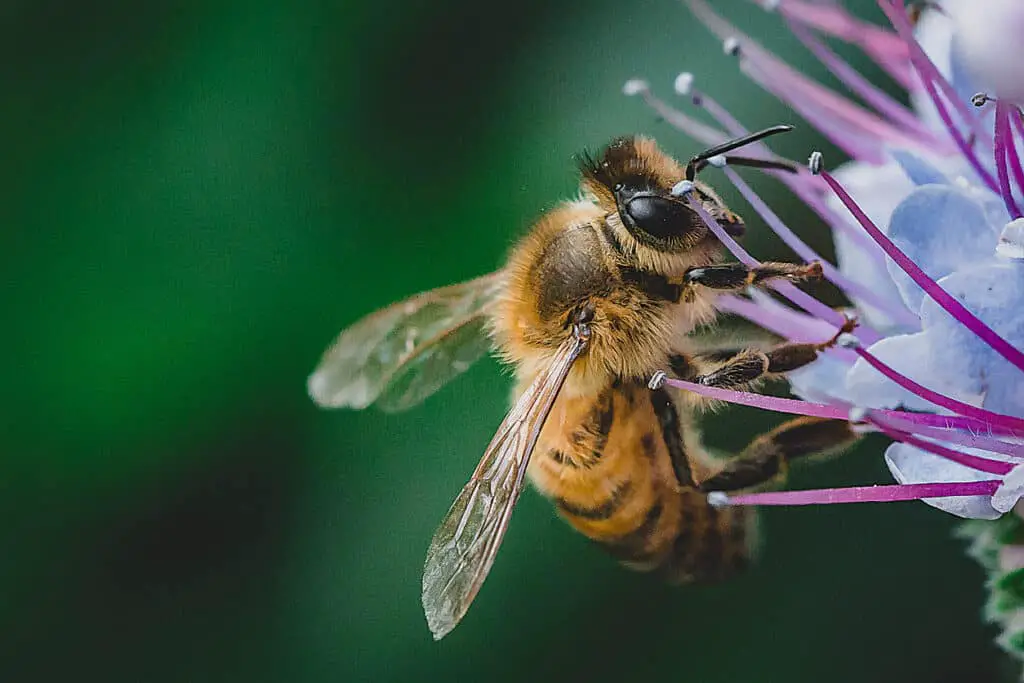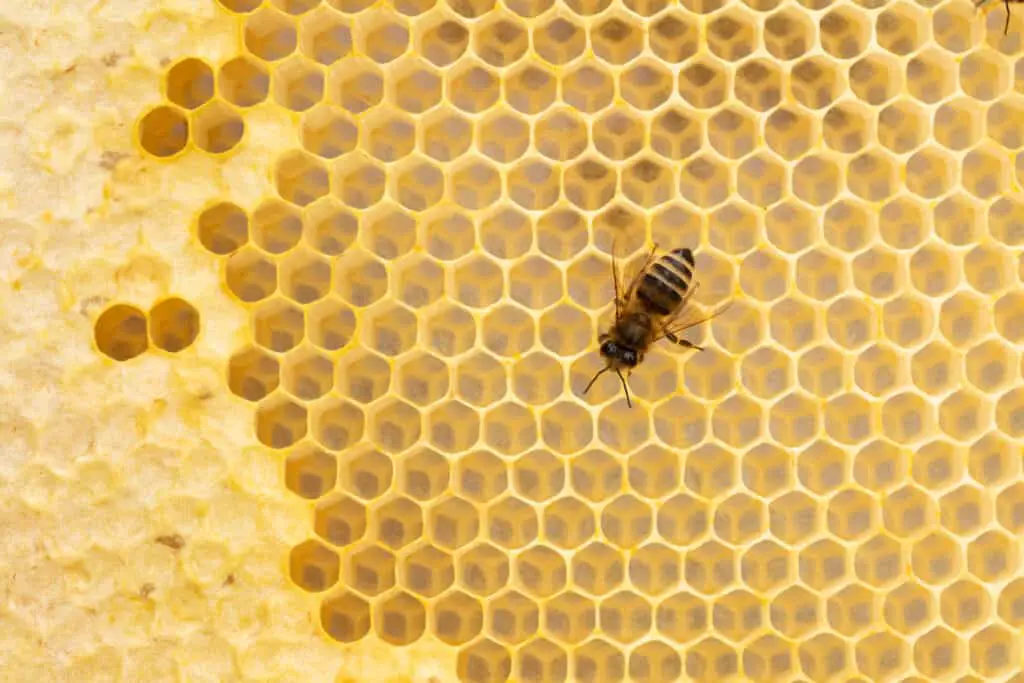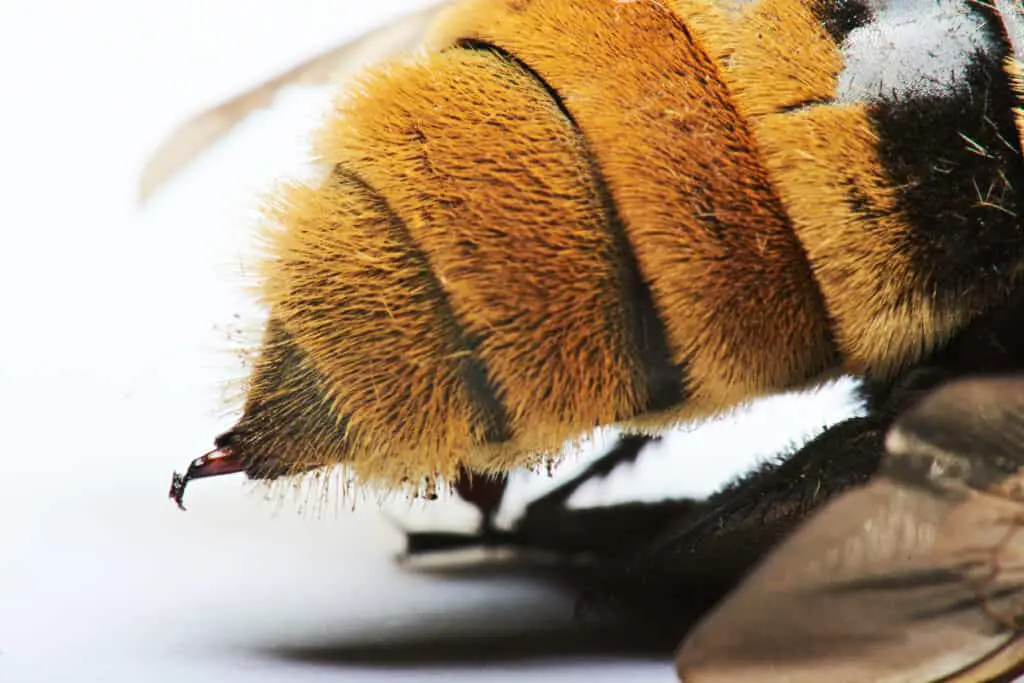Not all bees sting. Therefore, it is understandable to want to know if one of the most well-known bee species, the honey bee, can sting. Discover if these seemingly sweet-looking honey bees can sting by continuing to read.
Honey bees do sting. However, not every honey bee can sting, as only female honey bees can sting. These include the queen and worker bees. The male honey bees, also called drones, cannot sting. This is because drones do not have a stinger, so they are physically incapable of stinging.

In this article, we won’t simply answer whether honey bees sting or not, but we will also explore what colors attract honey bees and what kind of honey bee is the most aggressive.
Do Honey Bees Sting?

Not all bees sting. And of those that can sting, not all bee stings can cause harm. For instance, there is a species of bee called the ‘stingless bee’ whose stinger is so small that it cannot be used as a defense mechanism (i.e., they cannot sting). This bee belongs to the Apidae bee family, the same family as the honey bee and bumblebee.
Since the stingless bee and honey bee belong to the same family, one might assume that the honey bee cannot sting as well, right? To answer this question, let’s first discuss the anatomy of the honey bee. Honey bees have stingers. But unlike the stingless bee, the honey bee stinger is large enough to be used as a defense mechanism.
So, yes, honey bees do sting. But it is important to differentiate that not all honey bees can sting. Sounds confusing, right? Only female worker honey bees are able to sting. These female worker bees are the bees you would typically see collecting pollen and nectar for their colony. Worker bees are fascinating creatures as – although they are female – they are sterile when a queen is present.
They also do other jobs besides collecting pollen, such as making honey, housekeeping, and feeding the queen. On the other hand, male honey bees, called drones, do not sting. In fact, drones do not have a stinger, so they are physically incapable of stinging. Drones do not have much benefit for the colony. They do not gather nectar or pollen and cannot feed without the assistance of worker bees.
They have two purposes in life: to eat and mate. There is one other honey bee we have not discussed yet; the queen bee. The queen bee anatomically has a stinger and is able to sting. So, to summarize, only female honey bees can sting, whereas male honey bees cannot.
How Many Times Do Honey Bees Sting?

If you encounter a female worker, there is a chance that she might sting. Honey bees are known to have a barbed stinger. This means that when they sting, their stinger becomes lodged into the victim. After its stinger has left its body, the bee will then die. Queen honey bees are an entirely different scenario, though. Queen honey bees do not have barbed stingers and can repeatedly sting without dying.
However, there is a difference in the target of the worker honey bee and the queen bee. When worker bees feel threatened, they tend to sting humans and other animals. Worker bees are notoriously defensive over their colonies and will attack to defend them. Honey bees can also feel threatened in other ways, though.
For example, honey bees can attack when they sense an alarm pheromone of another bee. Bees release this pheromone when they are alerted by stimuli. Once they are on alert, they take a guarding stance and protrude their stingers, releasing the alert pheromone. Other attack stimulus includes hair, dark colors, and carbon dioxide.
The theory is that the common predators of the honey bee (think bears) are hairy, dark-colored, and exhale carbon dioxide. So it only makes sense that these kinds of stimuli can trigger aggression in worker bees. However, the aggression of the honey bee has one catch; they will not pursue their target over long distances -thankfully.
Africanized honey bees, on the other hand, can and will pursue their target over 100s meters. So it is best to avoid aggravating these bees and stay far away from them as possible. Africanized honey bees also have barbed stingers, meaning they can only sting once and soon after die.
Although it sounds reassuring that Africanized honey bees can only sting once, there is a much more concerning aspect to how many times these bees can sting. It is not that each bee can only sting once; it is that many more bees will sting! This is because Africanized honey bees are highly sensitive to alert pheromones.
So if one of these bees feels threatened, it is very likely that other bees will come to its defense. Africanized honey bees produce more alert pheromones than regular honey bees. And to add to this, Africanized honey bees have a lower stinging threshold response compared to their standard honey bee counterparts. This means that it doesn’t take much to set off an Africanized honey bee.
Africanized honey bees respond 2.4 times faster to alarm pheromones and are 30 times faster when faced with a moving target. Unfortunately, Africanized honey bees are more likely to swarm in groups to attack their target and have even been noted to travel 1km in pursuit. So proceed with caution where these bees are concerned. Conversely, queen honey bees are unlikely to attack humans.
Queen honey bees only tend to sting rival queens, i.e., other queens that are still developing, or they will fight ’til the death with other emerged queens. The last queen standing will take the throne and immediately start her responsibilities as queen.
Many beekeepers report that the queen keeps a docile and peaceful nature around them. Nevertheless, you should not actively cause aggression toward a queen bee.
Does Honey Bee Stings Hurt?
Most people find honey bee stings painful and uncomfortable. However, it is essential to realize that reactions to bee stings are different for everyone. What is more, just because you had one type of reaction to a bee sting does not mean you will get the same response the next time you are stung.
Bee sting reactions can vary from one sting to another. So, what type of reactions can you expect? Well, you might typically see three types of responses with honey bee stings; mild, moderate, and severe. We have listed what you might expect with these reactions below.
Mild Reaction
- Immediate, sharp burning sensation at the sting site
- Red bump at the sting area
- Slight swelling
For most people, swelling and pain should dissipate after a few hours.
Moderate Reaction
- Extreme redness
- Progressively worsening swelling that continues to worsen over the following days or weeks
Please note that developing a moderate reaction to a bee sting does not mean you will get a severe reaction the next time you are stung. Some people might consistently get moderate reactions when stung without it worsening. If you develop a moderate reaction, you can expect the symptoms to resolve anywhere between five and ten days.
If you find that you are consistently developing moderate reactions to bee stings or that your reactions get more severe, be sure to consult your medical practitioner about treatment and prevention.
Severe reaction
A small percentage of individuals can develop a severe reaction to a bee sting. Severe reactions (anaphylaxis) can be life-threatening and require immediate emergency treatment. Signs of anaphylaxis are:
- Difficulty breathing
- Swelling of the throat and tongue
- Wheezing
- Rapid heartbeat
- Skin reactions such as flushed or pale skin, hive or itching
- Confusion and anxiety
- Clammy skin
- Dizziness or fainting
- Stomach pain
- Loss of consciousness
People who develop a severe reaction to bee stings are about 25-65% more likely to develop anaphylaxis the next time they are stung. It’s therefore crucial that you seek immediate medical attention if symptoms arise and consult with your doctor or allergy specialist about preventative measures if you are stung again.
What Should I Do After Allergic Reaction To Bee Sting?
Allergic reactions such as anaphylaxis can be potentially life-threatening if left untreated. The best option is to call 911 or your local emergency contact number and inform them of your allergic reaction. Even if you are having a symptom or two that would suggest a severe allergic reaction, you should call the emergency contact number immediately.
If you have been prescribed an emergency epinephrine autoinjector (EpiPen, Auvi-Q, or others), administer it as soon as possible. In general, adrenaline (epinephrine) injection should be injected into the outer mid-though muscle.
Because adrenaline is a natural hormone response to stress, the administration of epinephrine will reduce symptoms of anaphylaxis by reducing throat swelling, opening the airways, and helping to maintain blood pressure and heart function.
How To Prevent Honey Bee Stings
Although you cannot control what bees can or cannot do in the wild, you can reduce your chances of getting stung. Here are some tips on reducing your chances of getting stung by a honey bee:
Do Not Have Food That Attracts Honey Bees
Food attracts bees. That’s why it is not uncommon to find a honey bee or two at your local market or Saturday barbeque. However, there are certain foods that reel in bees like a moth to a flame. Honey bees are especially fond of liquid sugars, so think sodas, watermelon, or frozen treats.
Interestingly, bees have also been observed to feed off of protein. So you may just find a bee hovering around your barbequed chicken. Prevent bees by covering up open foods (including your sodas) and remove all foods once you have finished eating as well as clear all dirty dishes of food.
Avoid Fruity or Flowery Scents That Attract Honey Bees
Bees are attracted to flowers because pollen and nectar are their primary food source. So if you smell like flowers, don’t be surprised if you find a honey bee following you. So consider refraining from your spring-time flowery-toned perfume. It is not just flowery perfumes that you have to watch out for, but anything that can give you a floral or fruity scent; lotions, colognes, hair spray, body spray, etc.
Wear The Right Clothing
Wearing long sleeves, long pants, and generally covering up as much surface area of skin can help prevent honey bees from landing on you and giving you a nasty sting. It is also suggested to wear closed shoes. So if you are going somewhere where you think there may be honey bees, consider altering your outfit for that occasion.
You might be surprised to know that your clothing color can also attract bees. Dark colors are sure to attract honey bees as these are said to mimic their natural predators like bears and skunks. So try to avoid dark colors where possible. Also, bright colors such as bright yellow, orange, and bright blue can attract the attention of the honey bee and increase your chances of getting stung.
They are attracted to these colors because their food sources (flowers) are typically endowed with bright hues of color. So try to avoid these colors too. Additionally, honey bees are especially drawn to purple, violet, and blue. So if you want to fly under the radar of the honey bee, it is best to wear neutral colors or white (beekeepers wear white for a reason).
Conclusion
Honey bees do sting. However, not all honey bees can sting. The female honey bees (the workers and queen) are able to sting. Male honey bees are unable to sting as they do not have a stinger. Worker honey bees have barbed stingers and die shortly after injecting their stinger into the victim. Queen honey bees do not have a barbed stinger and can repeatedly sting without dying.
Worker honey bees are more likely to sting humans and other animals as a means of self-defense. However, Africanized honey bees are more aggressive and are more likely to attack in a swarm. Queen bees typically only sting other queen bees. If you start to develop symptoms of a severe allergic reaction, seek medical attention immediately.
Sources
https://www.buzzaboutbees.net/do-all-bees-sting.html
https://en.wikipedia.org/wiki/Stingless_beehttps://bees.techno-science.ca/english/bees/life-in-a-hive/worker-bee.php#:~:text=Worker%20bees%20are%20female%20but,nectar%2C%20and%20making%20the%20wax.
https://labs.biology.ucsd.edu/nieh/TeachingBee/honeybee_aggession.htm
https://www.mayoclinic.org/diseases-conditions/bee-stings/symptoms-causes/syc-20353869
https://www.nhs.uk/conditions/anaphylaxis/
https://www.allergy.org.au/patients/allergy-treatment/adrenaline-for-severe-allergies
https://health.clevelandclinic.org/simple-steps-to-prevent-and-treat-bee-and-wasp-stings/

